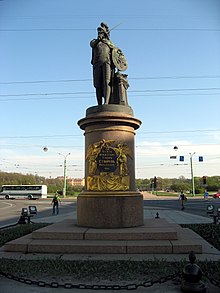Monument to the Revolution - The Field of Mars or Marsovo Polye
- Interments:
- 2view records
- Active from:
- -
- Active to:
- 00.00.1933
- Address:
- Tsentralnyy, Saint Petersburg, Russia
- Phone:
- -
- Email:
- -
- Homepage:
- -
- Owner:
- -
- Aim:
- -
- Political territory:
- -
- Area:
- 9.00 ha
- Categories:
- -
The Field of Mars or Marsovo Polye (Russian: Ма́рсово по́ле) is a large park named after the Mars - Roman god of war situated in the center ofSaint-Petersburg, with an area of about 9 hectares. Bordering the Field of Mars to the north are the Marble (Mramorny) Palace, Suvorova Square andBetskoi’s, Ficquelmont and Saltykov’s houses. To the west are the Barracks of the Pavlovsky Regiment. The Moyka River forms the boundary to the south.
History
The history of Field of Mars goes back to the first years of Saint-Petersburg. At that time it was called Grand Meadow. Later there were organised solemnities in the honour of the victory in the Great Northern War and the Field was renamed Pleasure Field (Poteshnoe Pole). In the 1740s Pleasure Field for a short while was turned into a walking park with paths, lawn and flowers. Its next name – Tsarina’s Meadow – appears after the royal family commissioned F.B. Rastrelli to build the Summer Palace for Empress Catherine I. But near the end of the 18th century Tsarina’s Meadow became a military drilling ground where they erected monuments commemorating the victories of the Russian Army and where parades and military studies took place regularly.

![]() The Field of Mars in the early 19th century.
The Field of Mars in the early 19th century.
In 1799 the Rumyantsev obelisk was placed in the center of the Field and in 1801 the monument to A. Suvorov was placed in the south section by M. Kozlovsky. A great military leader was represented as Mars (Roman god of war). In 1805 Tsarina’s Meadow was officially renamed Field of Mars. After the suggestion of Carlo Rossi the monument of A. Suvorov was moved to Suvorova Square. After the February Revolution in 1917 the Field of Mars finally lost its significance as a military drilling ground and became a memorial. In summer 1942 the Field of Mars was completely covered with vegetable gardens to supply the besieged Leningrad.
Buried people
After February Revolution
On 23 May 1917 the participants of February Revolution were buried there. 184 of 1382 citizens who were killed during the Revolution were buried in the common grave. In 1917-1919 a monument “To Fighters of Revolution” (architect – L. Rudnev) was erected above the graves. In 1918 the square was renamed to “The Place of the Victims of Revolution” but in 1944 it was renamed back.
Historical burial places

![]() Alexander Suvorov as a youthful Mars, by Mikhail Kozlovsky, 1799-1801
Alexander Suvorov as a youthful Mars, by Mikhail Kozlovsky, 1799-1801
- Avrov D.N. (1890–1922), revolutioner
- Volodarsky V. (1891–1918), revolutioner
- Voskov S.P. (1888–1920), revolutioner
- Gaza I.I. (1894–1933), military commander
- Grigor’ev N.S. (1890–1919), Bolshevik
- Eremeev K.S. (1874–1931), revolutioner, military commander
- Kotlyakov I.E.. (1885–1929), Bolshevik
- Kupshe A.I.. (?-1919), Red army commissar
- Lashevich М.М. (1884–1928), military commander
- Likhtenshtadt-Mazin V.O. (1882–1919), revolutioner
- Mgebrov-Chekan К. (1913–1922), revolutioner
- Mikhailov-Politikus L.M. (1872–1928), revolutioner
- Nakhimson S.M. (1885–1918), revolutioner
- Rakov A.S. (1885–1919), Red army commissar
- Rakh’ya I.A. (1887–1920)
- Sivers R.F. (1892–1918), military commander
- Tolmachev N.G. (1895–1919), military commander
- Uritsky M.S. (1873–1918), revolutioner
- Tsyperovich G.V. (1871–1932), revolutioner
Eternal Flame
On 6 November 1957 in the center of the Field was lit an Eternal Flame. It was the first in Russia. From here the Flame was delivered to Moscow in 1967 and was placed near Kremlin wall on the Tomb of Unknown Soldier. The Flame from the Field of Mars also burns on Piskaryovskoye Memorial Cemetery and on other memorials in Saint-Petersburg.
Sources: wikimapia.org
No events
